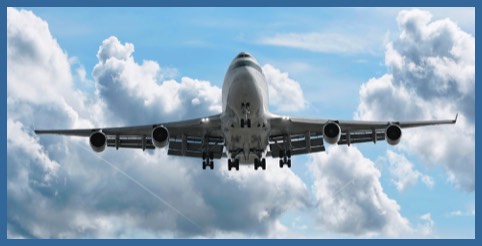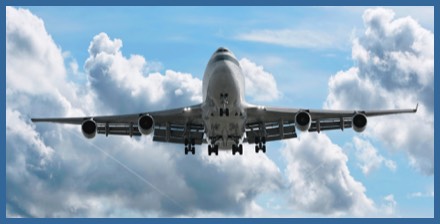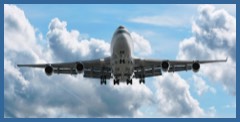Currently viewing
Menu
Corrosion in the Aircraft Industry

The estimated annual (1996) cost of corrosion for the Aircraft Industry in the USA was $2.225 Billion (Final Report FHWA-RD-01-156, 2001).
The importance of corrosion increases as the aircraft fleet ages beyond the originally intended service life. A design service life of 20 years is typical; however, this has been exceeded by as much as an additional 20 years in some cases.
The environment in which an aircraft operates can alter the corrosion characteristics. For example, operating in close proximity to a marine or corrosive industrial environment can accelerate the degradation mechanisms. The introduction of foreign materials such as oil, soil, battery acid, cleaning solutions, etc. can also alter the rate of degradation.
From the perspective of corrosion, there are a number of problematic areas in many aircraft. The engine exhaust can accelerate degradation, especially when deposits are trapped in hard-to-clean areas. Any area where moisture is trapped can negatively affect corrosion. Lavatories can represent problem areas, as human waste can be highly corrosive. Numerous other areas are also susceptible to corrosion damage.
Some of the more common forms of corrosion found on aircraft may include: surface corrosion - galvanic corrosion - filiform corrosion - fretting - stress corrosion cracking (SCC) - intergranular corrosion (IGC) - and exfoliation (a severe form of IGC associated with aluminum alloys).
One of the more recognizable aircraft incidents involving corrosion is the explosive decompression of an Aloha Airlines 737-200 in 1988. A large section of the upper part of the fuselage separated from the aircraft at 24,000 feet. There was one fatality and numerous injuries, but the crew were able to land the aircraft.
Although recent aircraft designs have incorporated composite components, this does not preclude the need to deal with corrosion issues. The numerous metallic parts utilized during fabrication still require careful monitoring and inspection.
The importance of corrosion increases as the aircraft fleet ages beyond the originally intended service life. A design service life of 20 years is typical; however, this has been exceeded by as much as an additional 20 years in some cases.
The environment in which an aircraft operates can alter the corrosion characteristics. For example, operating in close proximity to a marine or corrosive industrial environment can accelerate the degradation mechanisms. The introduction of foreign materials such as oil, soil, battery acid, cleaning solutions, etc. can also alter the rate of degradation.
From the perspective of corrosion, there are a number of problematic areas in many aircraft. The engine exhaust can accelerate degradation, especially when deposits are trapped in hard-to-clean areas. Any area where moisture is trapped can negatively affect corrosion. Lavatories can represent problem areas, as human waste can be highly corrosive. Numerous other areas are also susceptible to corrosion damage.
Some of the more common forms of corrosion found on aircraft may include: surface corrosion - galvanic corrosion - filiform corrosion - fretting - stress corrosion cracking (SCC) - intergranular corrosion (IGC) - and exfoliation (a severe form of IGC associated with aluminum alloys).
One of the more recognizable aircraft incidents involving corrosion is the explosive decompression of an Aloha Airlines 737-200 in 1988. A large section of the upper part of the fuselage separated from the aircraft at 24,000 feet. There was one fatality and numerous injuries, but the crew were able to land the aircraft.
Although recent aircraft designs have incorporated composite components, this does not preclude the need to deal with corrosion issues. The numerous metallic parts utilized during fabrication still require careful monitoring and inspection.

The estimated annual (1996) cost of corrosion for the Aircraft Industry in the USA was $2.225 Billion (Final Report FHWA-RD-01-156, 2001).
The importance of corrosion increases as the aircraft fleet ages beyond the originally intended service life. A design service life of 20 years is typical; however, this has been exceeded by as much as an additional 20 years in some cases.
The environment in which an aircraft operates can alter the corrosion characteristics. For example, operating in close proximity to a marine or corrosive industrial environment can accelerate the degradation mechanisms. The introduction of foreign materials such as oil, soil, battery acid, cleaning solutions, etc. can also alter the rate of degradation.
From the perspective of corrosion, there are a number of problematic areas in many aircraft. The engine exhaust can accelerate degradation, especially when deposits are trapped in hard-to-clean areas. Any area where moisture is trapped can negatively affect corrosion. Lavatories can represent problem areas, as human waste can be highly corrosive. Numerous other areas are also susceptible to corrosion damage.
Some of the more common forms of corrosion found on aircraft may include: surface corrosion - galvanic corrosion - filiform corrosion - fretting - stress corrosion cracking (SCC) - intergranular corrosion (IGC) - and exfoliation (a severe form of IGC associated with aluminum alloys).
One of the more recognizable aircraft incidents involving corrosion is the explosive decompression of an Aloha Airlines 737-200 in 1988. A large section of the upper part of the fuselage separated from the aircraft at 24,000 feet. There was one fatality and numerous injuries, but the crew were able to land the aircraft.
Although recent aircraft designs have incorporated composite components, this does not preclude the need to deal with corrosion issues. The numerous metallic parts utilized during fabrication still require careful monitoring and inspection.
The importance of corrosion increases as the aircraft fleet ages beyond the originally intended service life. A design service life of 20 years is typical; however, this has been exceeded by as much as an additional 20 years in some cases.
The environment in which an aircraft operates can alter the corrosion characteristics. For example, operating in close proximity to a marine or corrosive industrial environment can accelerate the degradation mechanisms. The introduction of foreign materials such as oil, soil, battery acid, cleaning solutions, etc. can also alter the rate of degradation.
From the perspective of corrosion, there are a number of problematic areas in many aircraft. The engine exhaust can accelerate degradation, especially when deposits are trapped in hard-to-clean areas. Any area where moisture is trapped can negatively affect corrosion. Lavatories can represent problem areas, as human waste can be highly corrosive. Numerous other areas are also susceptible to corrosion damage.
Some of the more common forms of corrosion found on aircraft may include: surface corrosion - galvanic corrosion - filiform corrosion - fretting - stress corrosion cracking (SCC) - intergranular corrosion (IGC) - and exfoliation (a severe form of IGC associated with aluminum alloys).
One of the more recognizable aircraft incidents involving corrosion is the explosive decompression of an Aloha Airlines 737-200 in 1988. A large section of the upper part of the fuselage separated from the aircraft at 24,000 feet. There was one fatality and numerous injuries, but the crew were able to land the aircraft.
Although recent aircraft designs have incorporated composite components, this does not preclude the need to deal with corrosion issues. The numerous metallic parts utilized during fabrication still require careful monitoring and inspection.

The estimated annual (1996) cost of corrosion for the Aircraft Industry in the USA was $2.225 Billion (Final Report FHWA-RD-01-156, 2001).
The importance of corrosion increases as the aircraft fleet ages beyond the originally intended service life. A design service life of 20 years is typical; however, this has been exceeded by as much as an additional 20 years in some cases.
The environment in which an aircraft operates can alter the corrosion characteristics. For example, operating in close proximity to a marine or corrosive industrial environment can accelerate the degradation mechanisms. The introduction of foreign materials such as oil, soil, battery acid, cleaning solutions, etc. can also alter the rate of degradation.
From the perspective of corrosion, there are a number of problematic areas in many aircraft. The engine exhaust can accelerate degradation, especially when deposits are trapped in hard-to-clean areas. Any area where moisture is trapped can negatively affect corrosion. Lavatories can represent problem areas, as human waste can be highly corrosive. Numerous other areas are also susceptible to corrosion damage.
Some of the more common forms of corrosion found on aircraft may include: surface corrosion - galvanic corrosion - filiform corrosion - fretting - stress corrosion cracking (SCC) - intergranular corrosion (IGC) - and exfoliation (a severe form of IGC associated with aluminum alloys).
One of the more recognizable aircraft incidents involving corrosion is the explosive decompression of an Aloha Airlines 737-200 in 1988. A large section of the upper part of the fuselage separated from the aircraft at 24,000 feet. There was one fatality and numerous injuries, but the crew were able to land the aircraft.
Although recent aircraft designs have incorporated composite components, this does not preclude the need to deal with corrosion issues. The numerous metallic parts utilized during fabrication still require careful monitoring and inspection.
The importance of corrosion increases as the aircraft fleet ages beyond the originally intended service life. A design service life of 20 years is typical; however, this has been exceeded by as much as an additional 20 years in some cases.
The environment in which an aircraft operates can alter the corrosion characteristics. For example, operating in close proximity to a marine or corrosive industrial environment can accelerate the degradation mechanisms. The introduction of foreign materials such as oil, soil, battery acid, cleaning solutions, etc. can also alter the rate of degradation.
From the perspective of corrosion, there are a number of problematic areas in many aircraft. The engine exhaust can accelerate degradation, especially when deposits are trapped in hard-to-clean areas. Any area where moisture is trapped can negatively affect corrosion. Lavatories can represent problem areas, as human waste can be highly corrosive. Numerous other areas are also susceptible to corrosion damage.
Some of the more common forms of corrosion found on aircraft may include: surface corrosion - galvanic corrosion - filiform corrosion - fretting - stress corrosion cracking (SCC) - intergranular corrosion (IGC) - and exfoliation (a severe form of IGC associated with aluminum alloys).
One of the more recognizable aircraft incidents involving corrosion is the explosive decompression of an Aloha Airlines 737-200 in 1988. A large section of the upper part of the fuselage separated from the aircraft at 24,000 feet. There was one fatality and numerous injuries, but the crew were able to land the aircraft.
Although recent aircraft designs have incorporated composite components, this does not preclude the need to deal with corrosion issues. The numerous metallic parts utilized during fabrication still require careful monitoring and inspection.
Currently viewing
Page last updated: 12/16/23
